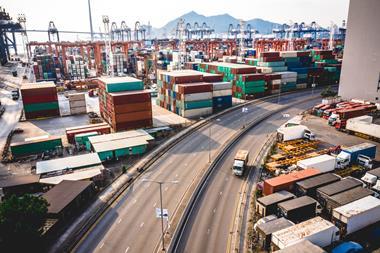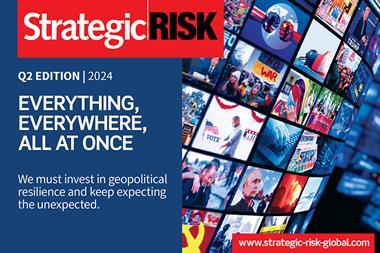Entropy constantly pushes the world towards volatility, but businesses must learn from ancient philosophy and find ways to combat threats, says risk expert Adriano Lanzilotto
Ancient people already knew everything.
Ancient cultures in Greece, India, Egypt and Tibet amongst others proposed to explain the nature and the complexity of all matter in terms of simpler substances.

According to them, the world around us is made of four basic elements: earth, water, air and fire. They thought that the combination of these four elements constituted everything we can touch, smell, hear and experience in this world.
As risk management professional, what I really hear is an irrefutable truth: that the perils of earthquake, flood, windstorm and fire are inherent hazards that are impossible to eliminate as they form the very tissue of reality and are intrinsic parts of the physical world as we know it.
And since we can’t avoid them, we need to learn how to control them, mitigate them and shape and mould them in our favour.
“The perils of earthquake, flood, windstorm and fire are inherent hazards that are impossible to eliminate”
Another way to interpret the ancient wisdom is that every material, building, equipment or natural manifestation, no matter how complex, tends by its nature to go back to one or more of these basic elements or reoccupy a space where nature and human activity have created something else, claiming back that space that its theirs by universal law.
Again, my professionally deformed mind uses this concept to explain why a building collapses (earth), why a chemical reactant burns (fire), why a river burst its banks (water), why a metal pipe rusts (earth,) and why hurricanes blow (air). These are inevitable processes that will happen sooner or later, and we can fight and delay only at the expense of some effort.
Defintion: Hazard - the tendency of anything to go back to its four constituents of fire, water, air and earth.
Return to simplicity
I find this concept quite akin to the concept of entropy.
If I remember my teenage science studies (a huge effort to fight the inevitable decay of my memory here!), entropy governs the thermodynamics of the universe and with that, all the processes occurring around us. It also explains why time flows in one direction only, from a state of lower entropy to a state of higher entropy.
Without an injection of energy to counteract it, entropy creates disorder from order: if you have a bucket full of sand (order state) and turn it upside down, the sand will scatter on the floor randomly (disorder).
The opposite will never happen naturally – the sand going spontaneously from the floor to your bucket - unless you are Harry Potter.
The process could be reversed only by applying energy (somebody collecting all the sand and refilling the glass), meaning that at the end you’ll have the sand back in your bucket, but the overall entropy of the universe or environment around you would have gone up due to the energy spent.
“When a system is brought to this final state of disorder we can say the risk is zero. In other words, it can’t get any worse!”
The entropy of the universe continuously increases, and it will do so until a point, in a billion years from now, where physical matter and energy will be everywhere with the same density, forming an homogenous state corresponding to maximum degree of disorder.
On a shorter timescale, anyone who has witnessed what remains after a devastating fire, flood or tornado knows what a high degree of disorder looks like.
A system that is in a high state of “order” - may be a building, a business or a supply chain with their own inner structures, or a river quietly flowing within its banks, has a high potential to go into a state of “disorder” if not actively maintained in such organised structure.
We call this potential “risk”. When a system is brought to this final state of disorder and homogeneity, with no movement at all - think about the aftermath of an explosion, a collapse or bankrupt - we can also say that at that point, the risk is zero. In other words, it can’t get any worse!
Defintion: Risk - the measure of how much entropy gets in the way of our intentions.
So can hazards be eliminated and can risk be reduced? Yes, but as per the entropy law, only with an injection of energy, work and money. Only with investments in loss prevention one can make sure that businesses fight the arrow of time and prevent volatility and losses.
Entropy comes from the Greek (again!) meaning “transformation”. Not surprisingly then, all four perils associated to the basic elements can change, and are indeed changing, assuming shapes and behaviours that are more and more difficult to model and predict.
Climate change is an aspect of this. For flood and wind the changing pattern is very evident. For every °C of average temperature increase on the earth surface, the air is able to absorb 7% more moisture.
The combined effect of the warming of the ocean waters and the capacity of the atmosphere to store more water enhances the potential for extreme precipitations, meaning floods are becoming more frequent, and more catastrophic. Same for hurricanes, that are becoming more intense in terms of wind speed.
In addition to this, the rise of the sea level in most parts of the world exposes coastal locations to an increased risk of flooding. With respect to fire, let’s remind ourselves that the fire risk has constantly evolved even before climate change was “a thing”.
”Can hazards be eliminated and can risk be reduced? Yes, but as per the entropy law, only with an injection of energy, work and money.”
Technological changes have and are continuously introducing new fire risks. An example of this is the different chemical composition of plastic materials used in construction and storage.
Today, climate change has accelerated these changes due to the transition to a greener economy. Examples are the extensive use of solar panels on roofs, the increased use of insulation materials to save energy, the development new battery technologies and the adoption of mass timber or other forms of wood construction.
And of course, there is also a direct fire risk that has been impacted directly by climate change, and this is wildfires. Wildfires are not necessarily more frequent than 15-20 years ago, but definitely more intense and extensive due to longer droughts.
What is apparently left outside is the earthquake peril. Even here though, if we look at the world using the scale of eons rather than centuries, seismic activity changes as the inner core of the Earth cools down and continental plates move and drift relatively to each other. But even on a human scale, one can also see potential links between human activities like deforestation and fracking and phenomena such as the melting of glaciers and permafrost, and the potential increase in earth movement events around the world.
I have told you a little lie.
We talked about four basic elements, but the Greeks also believed in the existence of a fifth element, the “quintessence”.
They thought that the stars and the skies must have been made of something incorruptible and eternal, something that didn’t change and therefore not one of the four elements previously discussed. They called this elusive, invisible element “aether”.
Aether was the substance of what the Sun, the Moon and the stars are made, the pure essence that the gods breathed, but it was also what forms the void between matter. The concept of ether was used to explain natural phenomena such as the travelling of light and gravity, apparently there even in absence of a tangible medium like air.
In my analogy, I like to compare the aether with the internet and with another risk threatening supply chains in modern days: cyber risk.

Like the aether, global communication and interconnection is necessary, ubiquitous and invisible. Where the ancient Greeks might have been wrong, or where my analogy is weak, is the fact that while aether was considered immutable, unfortunately also the cyber risk is changing, and very rapidly.
Traditionally, cyber has been the domain of Information Technology (IT). However, think for a minute about the key differences between the Information Technology (IT) and the Operational Technology (OT) environments in any modern industrial or commercial organisation.
As an example, while we have multiple authentication factors and ever more complex passwords governing our access to Internet banking and shared folders in our company’s systems, it’s not rare to see pet names on post-its attached to control panels in any industrial plant control room.
The different approach to cyber risk between IT and OT environments create gaps that are fueling the cyber risk transformation. And if we look at the trends of cyber criminality in the last few years, we can’t avoid noticing a shift from pure disruption intent (Petya & Wannacry) to monetisation through ransomware (Ryuk and Cryptolocker).
”The different approach to cyber risk between IT and OT environments create gaps that are fueling the cyber risk transformation.”
What’s next? Well, the gaps I have explained above between IT and OT mean that it’s likely that the next generation of cyber attacks will aim at causing some physical damage in infrastructures and equipment.
This is again something that can only be counteracted by investing in safe procedures and systems addressing that borderline between IT and OT, i.e. those Industrial Control Systems that are interfaced with the broader internet.
So in conclusion, risk is everywhere and cannot be avoided. Entropy constantly pushes the world towards volatility and uncertainty. It’s up to individuals, businesses and governments to apply efforts and make investments to combat them and make sure human enterprise and progress is adequately protected and resilient.
And if in doubt, go to the nearest library and visit the section ancient philosophers, you may find the answers you were looking for.
Adriano Lanzilotto helps risk managers, CROs and insurance buyers assess and manage their property risks, optimise their risk transfer strategies, raise their profile within their organisations and make their businesses more resilient.




















No comments yet